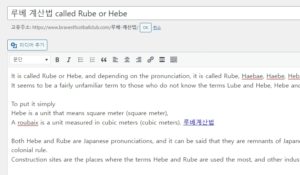It is called Rube or Hebe, and depending on the pronunciation, it is called Rube, Haebae, Haebe, Hebae, etc.
It seems to be a fairly unfamiliar term to those who do not know the terms Lube and Hebe, Hebe and Ruberarn.
To put it simply
Hebe is a unit that means square meter (square meter),
A roubaix is a unit measured in cubic meters (cubic meters). 루베계산법
Both Hebe and Rube are Japanese pronunciations, and it can be said that they are remnants of Japanese colonialism that Korea has been using since the time of Japanese colonial rule.
Construction sites are the places where the terms Hebe and Rube are used the most, and other industries, legal circles, and public officials use them a lot.
Meaning of rube hebe units, how to calculate rube and hebe units, the meaning of heber hebe
hebe unit 인생꿀팁
One hebe is 1 square meter, and expressed as a unit, it is 1 square meter (m2).
To put it bluntly, 1 hebe is a case of 1 meter in width × 1 meter in height.
For example, in the case of a width of 2 meters and a length of 5 meters, it is necessary to multiply the width and length to obtain 10 square meters (10 ㎡), which is called 10 hebe.
Hebe is only used to express area in square meters (square meters).
One of the most commonly used units is the pyeong.
It is most often used when talking about the area of an apartment.
The government tried to change the unit of pyeong to square meters so that the unit is mainly used in the United States, but it does not seem to have the effect as expected.
Even if you look at an apartment model house, in the case of an apartment of 30 pyeong, it is written as 99 m2 and next to it as 30 type, so that it can be easily recognized that it is 30 pyeong.
One pyeong is six cubits square, and refers to the area of six cubits wide and six cubits tall.
To put it simply, 6 characters × 6 characters is one pyeong.
If 1 pyeong is converted into square meters, it is about 3.3058 ㎡. Therefore, roughly 3.3 m² is calculated as 1 pyeong.
The unit of 1 pyeong was coined as a unit that started when a person could lie down with arms and legs spread out.
In other words, it refers to the area where one person can comfortably lie down without bumping into another person.
Hebe came to be called at the construction site during the Japanese colonial era in the past when the unit called Hebe was still called at the construction site as it was called “Hebe” by shortening the Japanese pronunciation “Heibou Bay”.
Meaning of rube hebe units, how to calculate rube and hebe units, the meaning of heber hebe
roubaix unit
One lube is 1 cubic meter, and expressed as a unit, it is 1 m3 (m3).
To put it bluntly, 1 roulette is 1 meter wide × 1 meter long × 1 meter high.
For example, in the case of a width of 2 meters, a length of 5 meters, and a height of 3 meters, the width, length, and height are multiplied by 2 × 5 × 3 = 30 cubic meters (cubic meter, ㎥), which is called 30 rouves.
Hebe is a unit used to represent area, and roube is used to represent volume (volume).
In the case of pouring cement at a construction site, if only the width × length is multiplied, the amount of cement varies according to the height.
When we talk about the amount of cement when pouring cement or the amount of soil excavated when digging up soil, we should talk about volume.
In this case, you need to use a roulette that calculates width × length × height.
 , and the pronunciation of “Ryu-be” was made easier, so it was changed to “Rube” and used.
, and the pronunciation of “Ryu-be” was made easier, so it was changed to “Rube” and used.